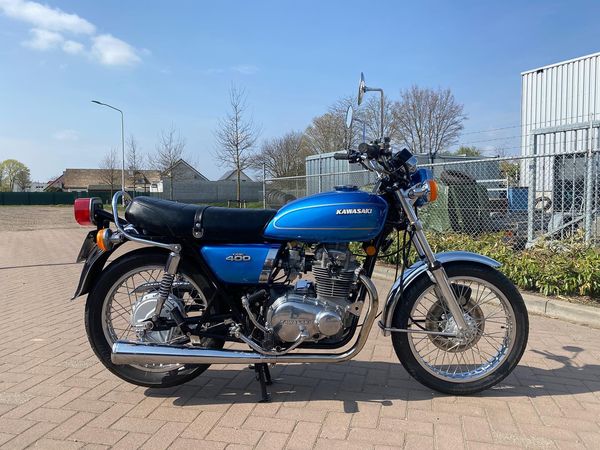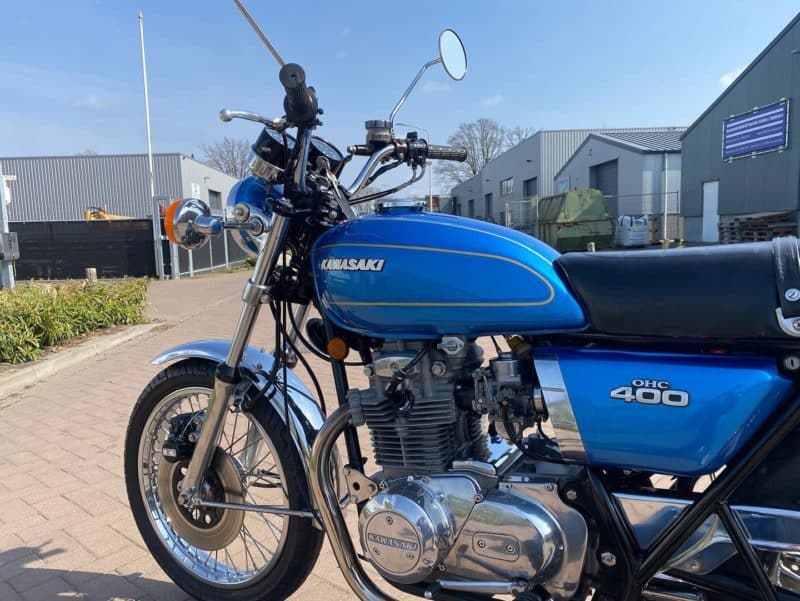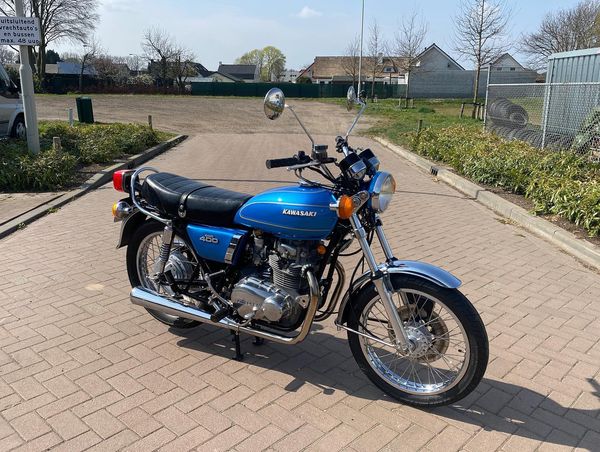Adrie te Veldhuis from Arnhem is an almost compulsive beautifier. He is therefore the man behind this Kawasaki KZ400 that we saw at Vintage Motorcycles in Someren. The Kawasaki looks captivating. Firstly, the 400 cc twin still has pure classic lines. But it is also 100% spotless.
It looks like the 1976'er comes straight out of its box. The history of the Z/KZ400 is not easy to find. Even if you study the books on classic Japanese motorcycles, you will find very little about them. The Kawasaki KZ400 had a fairly anonymous life throughout its 10-year production history that began in 1973 and ended in 1983. It was good, but it didn't break hearts. Suitable for daily use. It sold fairly to well in the UK and US. In the UK, the Kawa fitted into the commuter mindset. In the United States, they were just shocked by the recent gasoline prices.
But impressive or horrifying? Well no... Over the years, as bikes in general got bigger and more powerful, the Kawasaki KZ400 was considered a beginner's bike and not a future classic worth cherishing. They were cheap to buy, easy to maintain, and there was always another beginner you could sell them to if you were going to buy a bigger bike.
Today the situation is a bit different for the humble 400. Now there is a booming interest in collecting and restoring classic Japanese bicycles all over the world. In addition, the prices of the toppers of that time skyrocketed. And the Kawasaki KZ400 is therefore one of the models that are becoming increasingly popular both in terms of appearance and engine construction. It has the classic look, and the engine is easy to build and maintain, and the prices are modest compared to other classics so far.
And since there was very little interest in tuning and modifying the KZ70 in the 80s and 400s, and very few tuning parts were available back then, a large number of running, original bikes can still be found today. Spare part availability is also better than for many bikes of the same era. The KZ400 was Kawasaki's attempt to get into the middleweight four-stroke class, where Honda ruled with their CB350 and CB360 twins. Testers often compared it to the Hondas. One of the big differences was that Honda had opted for the 180-degree crankshaft, while Kawasaki chose to build an engine with a 'classic' 360-degree crankshaft, which was equipped with a dynamic balancing system.
And the system worked, the course of the block was described as silky smooth, and a well-tuned Kawasaki KZ400 engine runs almost as smoothly as a four of the era. The engine was described as surprisingly tight on the throttle and it pulled well from 2500 rpm to the red zone that started at 9500 rpm. And the fuel consumption was very good during the oil crisis. The only real complaint about the engine was overhead oil leaks, a problem that followed the KZ400 until the 1978 model's redesigned upper cylinder head. Also, the untensioned Hy-Vo primary chain rattled at idle. Not that there was a technical problem on the early models, but it was described as annoying. Moreover: the beautiful engine block was not very quiet in the mechanical field, in accordance with Kawasaki's tradition. And let's just like that again!
Oh yes: the days when you had a neat Kawasaki KZ400 for 1.500 euros are over. But it remains much cheaper than a Z1. And it is more usable in all areas and fast and dynamic enough to earn the official 'Sponsor of the CJIB' sticker.






photos: Adrie te Veldhuis/ Vintage Motorcycles



nice engine
Nice!!
I myself have one in my collection, but then the brown gold metallic.
Except for one exhaust in very nice condition.
Marina Lamerant
So that will be looking for an exhaust!
They are also beautiful but undervalued city bikes. Kawasaki had a reputation to uphold with mechanical engine noise. They were otherwise great 'bikes', weren't they?
The smaller sub-500cc bikes are still considered undersized, beginners or teaching bikes... (or 'women's bike'...).
While they are so incredibly practical and fully usable, especially in our contemporary 100 km / h society.
'Unloved makes it a neglected child', which says something like 'don't hurt the wallet'…
And they are so nice to have..
Keep it between us. Soon we won't be able to afford them anymore!